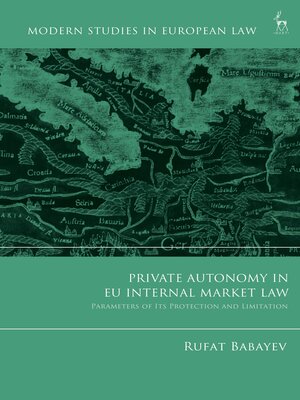Private Autonomy in EU Internal Market Law
ebook ∣ Parameters of its Protection and Limitation · Modern Studies in European Law
By Rufat Babayev

Sign up to save your library
With an OverDrive account, you can save your favorite libraries for at-a-glance information about availability. Find out more about OverDrive accounts.
Find this title in Libby, the library reading app by OverDrive.



Search for a digital library with this title
Title found at these libraries:
| Library Name | Distance |
|---|---|
| Loading... |
Ambitious and innovative, this important study offers a fresh perspective on the normative framework of the EU's internal market.
The book explores the place of the ideals of private autonomy in the EU's legal order. Indeed, it goes further to explore the parameters of their protection within both its legal and regulatory framework. Looking at the coexistence of, and interaction between, varying expressions of private autonomy, it offers a comprehensive review of the protection of private autonomy at the normative core of the internal market. The book also explores the layers of limitations and conditions imposed on the exercise of private autonomy that generate legal tensions and conflicting forces.
In addition to plotting a systematic approach to the question, the book introduces a new framework for better understanding the correlation between the free movement and competition law regimes and the fundamental economic rights protected in the Charter.
The book explores the place of the ideals of private autonomy in the EU's legal order. Indeed, it goes further to explore the parameters of their protection within both its legal and regulatory framework. Looking at the coexistence of, and interaction between, varying expressions of private autonomy, it offers a comprehensive review of the protection of private autonomy at the normative core of the internal market. The book also explores the layers of limitations and conditions imposed on the exercise of private autonomy that generate legal tensions and conflicting forces.
In addition to plotting a systematic approach to the question, the book introduces a new framework for better understanding the correlation between the free movement and competition law regimes and the fundamental economic rights protected in the Charter.







